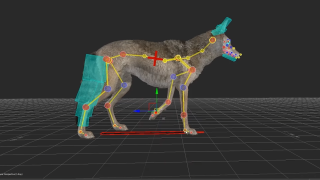# Exploring UbiSoft’s AI-Driven ZooBuilder: A New Era in Animation
Written on
Animal Animation Revolution
Motion capture, or mocap, utilizes specialized suits fitted with sensors to track an actor's movements, transforming those data into lifelike characters for video games and films. However, applying this method to animals poses significant challenges. Imagine trying to fit a mocap suit on a grizzly bear—it's a daunting task.
This article delves into ZooBuilder, an innovative AI video tool from Ubisoft that represents a transformative shift in how AI impacts the gaming and film sectors.
Challenges in Animal Animation
Traditionally, animating animals in video games has relied heavily on manual techniques. This typically involves creating animations frame by frame or attempting to use mocap suits designed for animals.
Even with a mocap suit, capturing the true essence of animal movements is incredibly challenging. Directing a dog, for instance, is vastly different from working with human actors. You can't simply instruct a dog to repeat an action with specific adjustments like you could with a person.
This whole process can be not only labor-intensive but also often fails to encapsulate the full range of animal motion.
ZooBuilder: The Game-Changer
Ubisoft’s research team, known as Ubisoft La Forge, has developed ZooBuilder, a tool that employs machine learning algorithms to autonomously generate animal animations from existing video recordings. Unlike traditional Video-to-Video models, ZooBuilder meticulously analyzes input videos to identify the coordinates of an animal's joints. It then constructs a virtual skeleton, which is further translated into 3D coordinates, resulting in incredibly realistic animations that reflect the intricate nature of animal movements.

Collaborative Creativity
ZooBuilder is crafted as a supportive AI tool aimed at enhancing, not replacing, the role of animators. By efficiently generating the foundational prototypes of 3D animated animals, ZooBuilder alleviates the burden of repetitive tasks, allowing artists to channel their energy into adding intricate details and nuances that bring characters to life.
Future Prospects
Although ZooBuilder remains in the prototype stage and hasn't yet entered full production, its potential is exciting. By reducing the manual labor and complexity traditionally linked to animal animation, artists can devote more time to storytelling, creativity, and artistic excellence. This not only enhances the quality of the final product but may also pave the way for new forms of media and educational opportunities at the intersection of AI and virtual reality.
The implications of ZooBuilder could extend well beyond the gaming realm, potentially revolutionizing the film industry and contributing to more realistic representations of wildlife, which could help mitigate animal cruelty concerns in the long run.
Virtual zoos, anyone?
If you appreciate this content, consider leaving a “clap” at the end of the article to help others discover it!